Changhua Meng
Careful Queries, Credible Results: Teaching RAG Models Advanced Web Search Tools with Reinforcement Learning
Aug 11, 2025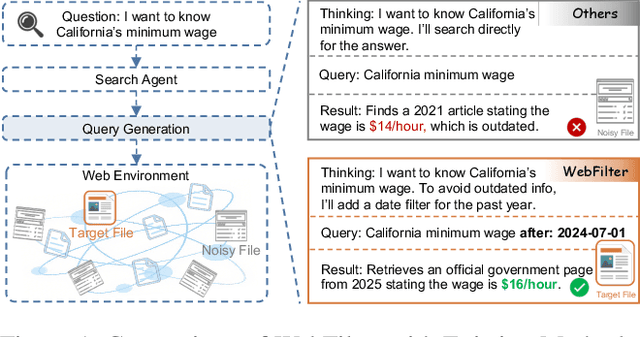

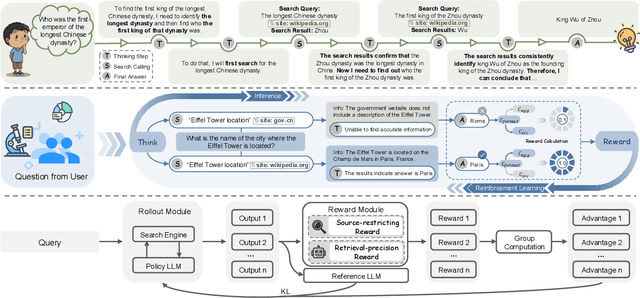
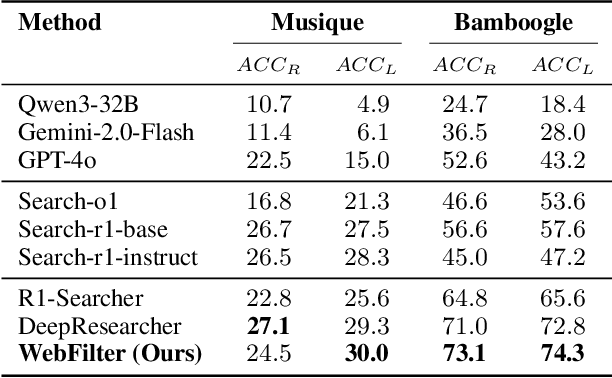
Abstract:Retrieval-Augmented Generation (RAG) enhances large language models (LLMs) by integrating up-to-date external knowledge, yet real-world web environments present unique challenges. These limitations manifest as two key challenges: pervasive misinformation in the web environment, which introduces unreliable or misleading content that can degrade retrieval accuracy, and the underutilization of web tools, which, if effectively employed, could enhance query precision and help mitigate this noise, ultimately improving the retrieval results in RAG systems. To address these issues, we propose WebFilter, a novel RAG framework that generates source-restricted queries and filters out unreliable content. This approach combines a retrieval filtering mechanism with a behavior- and outcome-driven reward strategy, optimizing both query formulation and retrieval outcomes. Extensive experiments demonstrate that WebFilter improves answer quality and retrieval precision, outperforming existing RAG methods on both in-domain and out-of-domain benchmarks.
GraphRPM: Risk Pattern Mining on Industrial Large Attributed Graphs
Nov 11, 2024Abstract:Graph-based patterns are extensively employed and favored by practitioners within industrial companies due to their capacity to represent the behavioral attributes and topological relationships among users, thereby offering enhanced interpretability in comparison to black-box models commonly utilized for classification and recognition tasks. For instance, within the scenario of transaction risk management, a graph pattern that is characteristic of a particular risk category can be readily employed to discern transactions fraught with risk, delineate networks of criminal activity, or investigate the methodologies employed by fraudsters. Nonetheless, graph data in industrial settings is often characterized by its massive scale, encompassing data sets with millions or even billions of nodes, making the manual extraction of graph patterns not only labor-intensive but also necessitating specialized knowledge in particular domains of risk. Moreover, existing methodologies for mining graph patterns encounter significant obstacles when tasked with analyzing large-scale attributed graphs. In this work, we introduce GraphRPM, an industry-purpose parallel and distributed risk pattern mining framework on large attributed graphs. The framework incorporates a novel edge-involved graph isomorphism network alongside optimized operations for parallel graph computation, which collectively contribute to a considerable reduction in computational complexity and resource expenditure. Moreover, the intelligent filtration of efficacious risky graph patterns is facilitated by the proposed evaluation metrics. Comprehensive experimental evaluations conducted on real-world datasets of varying sizes substantiate the capability of GraphRPM to adeptly address the challenges inherent in mining patterns from large-scale industrial attributed graphs, thereby underscoring its substantial value for industrial deployment.
Mirror-Consistency: Harnessing Inconsistency in Majority Voting
Oct 07, 2024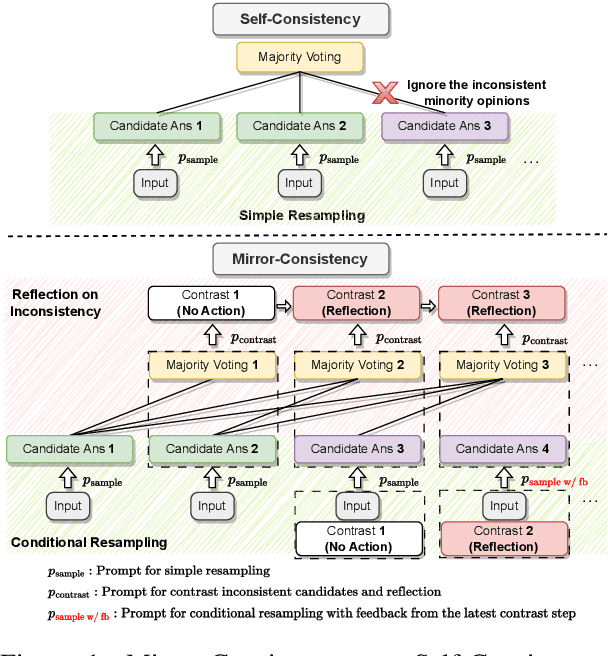
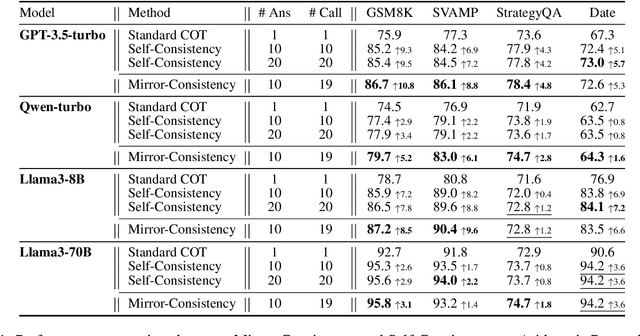
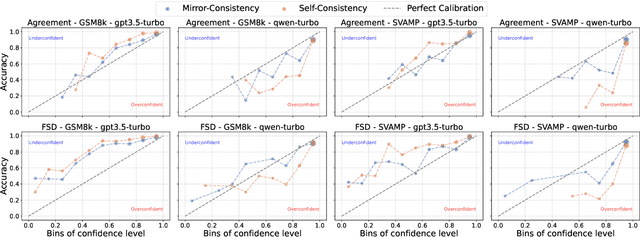
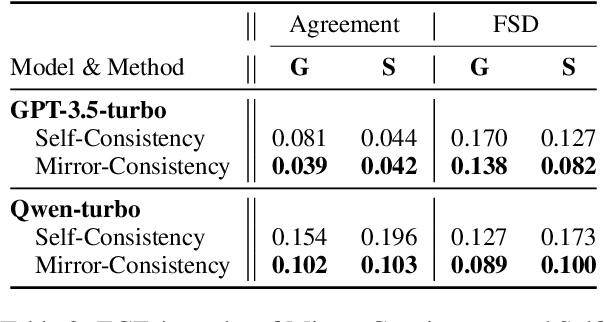
Abstract:Self-Consistency, a widely-used decoding strategy, significantly boosts the reasoning capabilities of Large Language Models (LLMs). However, it depends on the plurality voting rule, which focuses on the most frequent answer while overlooking all other minority responses. These inconsistent minority views often illuminate areas of uncertainty within the model's generation process. To address this limitation, we present Mirror-Consistency, an enhancement of the standard Self-Consistency approach. Our method incorporates a 'reflective mirror' into the self-ensemble decoding process and enables LLMs to critically examine inconsistencies among multiple generations. Additionally, just as humans use the mirror to better understand themselves, we propose using Mirror-Consistency to enhance the sample-based confidence calibration methods, which helps to mitigate issues of overconfidence. Our experimental results demonstrate that Mirror-Consistency yields superior performance in both reasoning accuracy and confidence calibration compared to Self-Consistency.
PC$^2$: Pseudo-Classification Based Pseudo-Captioning for Noisy Correspondence Learning in Cross-Modal Retrieval
Aug 02, 2024



Abstract:In the realm of cross-modal retrieval, seamlessly integrating diverse modalities within multimedia remains a formidable challenge, especially given the complexities introduced by noisy correspondence learning (NCL). Such noise often stems from mismatched data pairs, which is a significant obstacle distinct from traditional noisy labels. This paper introduces Pseudo-Classification based Pseudo-Captioning (PC$^2$) framework to address this challenge. PC$^2$ offers a threefold strategy: firstly, it establishes an auxiliary "pseudo-classification" task that interprets captions as categorical labels, steering the model to learn image-text semantic similarity through a non-contrastive mechanism. Secondly, unlike prevailing margin-based techniques, capitalizing on PC$^2$'s pseudo-classification capability, we generate pseudo-captions to provide more informative and tangible supervision for each mismatched pair. Thirdly, the oscillation of pseudo-classification is borrowed to assistant the correction of correspondence. In addition to technical contributions, we develop a realistic NCL dataset called Noise of Web (NoW), which could be a new powerful NCL benchmark where noise exists naturally. Empirical evaluations of PC$^2$ showcase marked improvements over existing state-of-the-art robust cross-modal retrieval techniques on both simulated and realistic datasets with various NCL settings. The contributed dataset and source code are released at https://github.com/alipay/PC2-NoiseofWeb.
Revisiting Modularity Maximization for Graph Clustering: A Contrastive Learning Perspective
Jun 20, 2024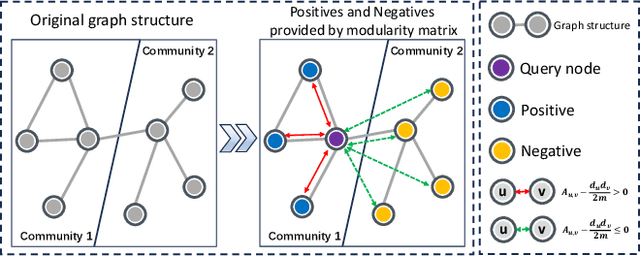
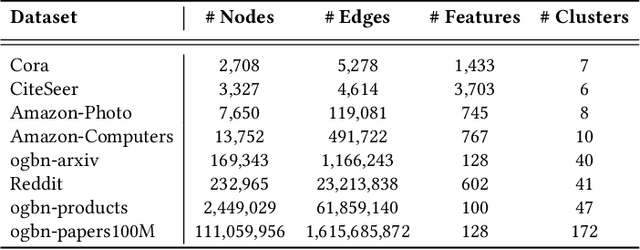

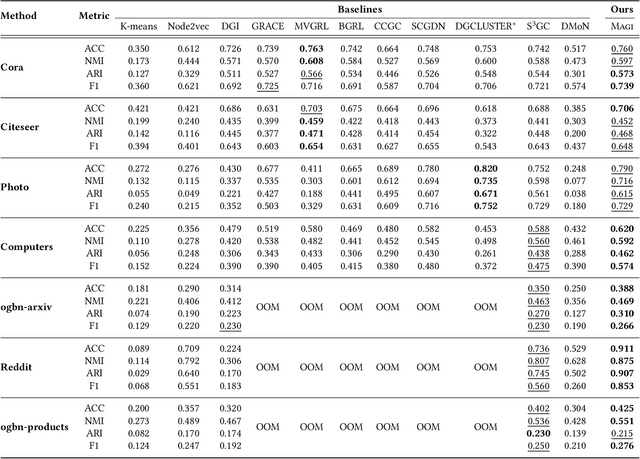
Abstract:Graph clustering, a fundamental and challenging task in graph mining, aims to classify nodes in a graph into several disjoint clusters. In recent years, graph contrastive learning (GCL) has emerged as a dominant line of research in graph clustering and advances the new state-of-the-art. However, GCL-based methods heavily rely on graph augmentations and contrastive schemes, which may potentially introduce challenges such as semantic drift and scalability issues. Another promising line of research involves the adoption of modularity maximization, a popular and effective measure for community detection, as the guiding principle for clustering tasks. Despite the recent progress, the underlying mechanism of modularity maximization is still not well understood. In this work, we dig into the hidden success of modularity maximization for graph clustering. Our analysis reveals the strong connections between modularity maximization and graph contrastive learning, where positive and negative examples are naturally defined by modularity. In light of our results, we propose a community-aware graph clustering framework, coined MAGI, which leverages modularity maximization as a contrastive pretext task to effectively uncover the underlying information of communities in graphs, while avoiding the problem of semantic drift. Extensive experiments on multiple graph datasets verify the effectiveness of MAGI in terms of scalability and clustering performance compared to state-of-the-art graph clustering methods. Notably, MAGI easily scales a sufficiently large graph with 100M nodes while outperforming strong baselines.
E-ANT: A Large-Scale Dataset for Efficient Automatic GUI NavigaTion
Jun 20, 2024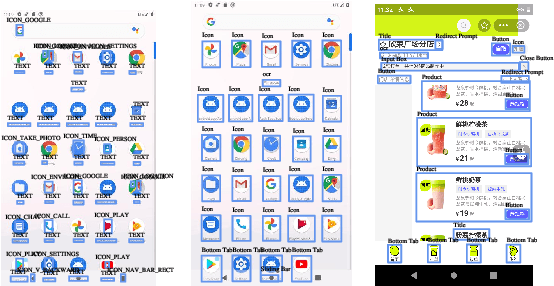
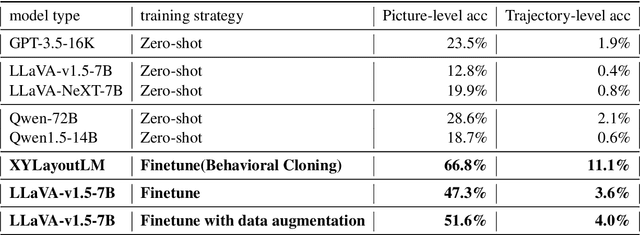

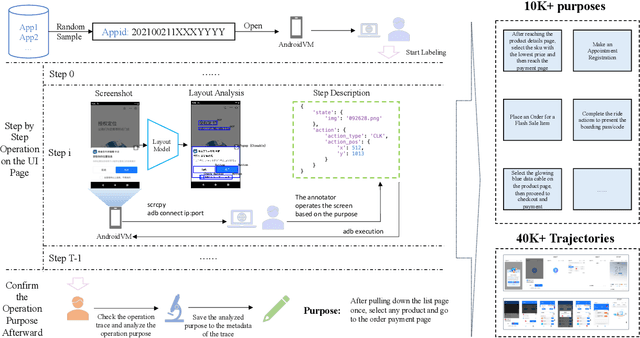
Abstract:Online GUI navigation on mobile devices has driven a lot of attention recent years since it contributes to many real-world applications. With the rapid development of large language models (LLM), multimodal large language models (MLLM) have tremendous potential on this task. However, existing MLLMs need high quality data to improve its abilities of making the correct navigation decisions according to the human user inputs. In this paper, we developed a novel and highly valuable dataset, named \textbf{E-ANT}, as the first Chinese GUI navigation dataset that contains real human behaviour and high quality screenshots with annotations, containing nearly 40,000 real human traces over 5000+ different tinyAPPs. Furthermore, we evaluate various powerful MLLMs on E-ANT and show their experiments results with sufficient ablations. We believe that our proposed dataset will be beneficial for both the evaluation and development of GUI navigation and LLM/MLLM decision-making capabilities.
TroubleLLM: Align to Red Team Expert
Feb 28, 2024Abstract:Large Language Models (LLMs) become the start-of-the-art solutions for a variety of natural language tasks and are integrated into real-world applications. However, LLMs can be potentially harmful in manifesting undesirable safety issues like social biases and toxic content. It is imperative to assess its safety issues before deployment. However, the quality and diversity of test prompts generated by existing methods are still far from satisfactory. Not only are these methods labor-intensive and require large budget costs, but the controllability of test prompt generation is lacking for the specific testing domain of LLM applications. With the idea of LLM for LLM testing, we propose the first LLM, called TroubleLLM, to generate controllable test prompts on LLM safety issues. Extensive experiments and human evaluation illustrate the superiority of TroubleLLM on generation quality and generation controllability.
LasTGL: An Industrial Framework for Large-Scale Temporal Graph Learning
Nov 30, 2023



Abstract:Over the past few years, graph neural networks (GNNs) have become powerful and practical tools for learning on (static) graph-structure data. However, many real-world applications, such as social networks and e-commerce, involve temporal graphs where nodes and edges are dynamically evolving. Temporal graph neural networks (TGNNs) have progressively emerged as an extension of GNNs to address time-evolving graphs and have gradually become a trending research topic in both academics and industry. Advancing research and application in such an emerging field necessitates the development of new tools to compose TGNN models and unify their different schemes for dealing with temporal graphs. In this work, we introduce LasTGL, an industrial framework that integrates unified and extensible implementations of common temporal graph learning algorithms for various advanced tasks. The purpose of LasTGL is to provide the essential building blocks for solving temporal graph learning tasks, focusing on the guiding principles of user-friendliness and quick prototyping on which PyTorch is based. In particular, LasTGL provides comprehensive temporal graph datasets, TGNN models and utilities along with well-documented tutorials, making it suitable for both absolute beginners and expert deep learning practitioners alike.
Hetero$^2$Net: Heterophily-aware Representation Learning on Heterogenerous Graphs
Oct 18, 2023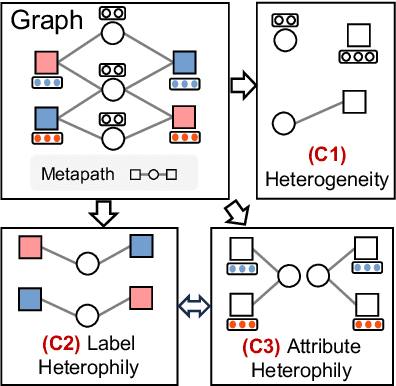
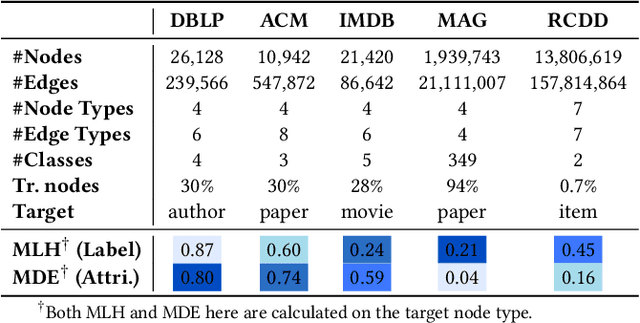
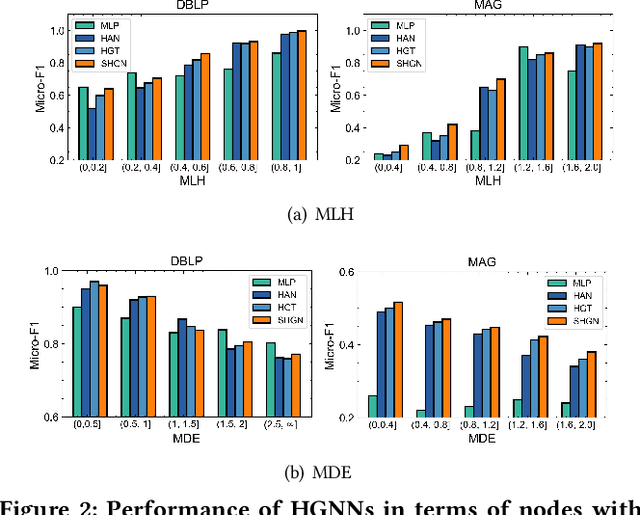
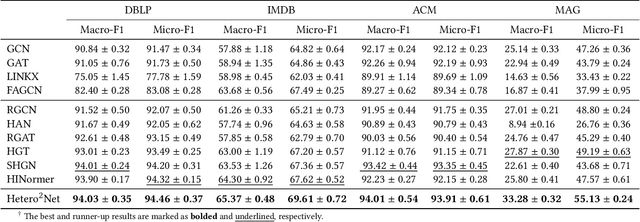
Abstract:Real-world graphs are typically complex, exhibiting heterogeneity in the global structure, as well as strong heterophily within local neighborhoods. While a growing body of literature has revealed the limitations of common graph neural networks (GNNs) in handling homogeneous graphs with heterophily, little work has been conducted on investigating the heterophily properties in the context of heterogeneous graphs. To bridge this research gap, we identify the heterophily in heterogeneous graphs using metapaths and propose two practical metrics to quantitatively describe the levels of heterophily. Through in-depth investigations on several real-world heterogeneous graphs exhibiting varying levels of heterophily, we have observed that heterogeneous graph neural networks (HGNNs), which inherit many mechanisms from GNNs designed for homogeneous graphs, fail to generalize to heterogeneous graphs with heterophily or low level of homophily. To address the challenge, we present Hetero$^2$Net, a heterophily-aware HGNN that incorporates both masked metapath prediction and masked label prediction tasks to effectively and flexibly handle both homophilic and heterophilic heterogeneous graphs. We evaluate the performance of Hetero$^2$Net on five real-world heterogeneous graph benchmarks with varying levels of heterophily. The results demonstrate that Hetero$^2$Net outperforms strong baselines in the semi-supervised node classification task, providing valuable insights into effectively handling more complex heterogeneous graphs.
Self-supervision meets kernel graph neural models: From architecture to augmentations
Oct 17, 2023
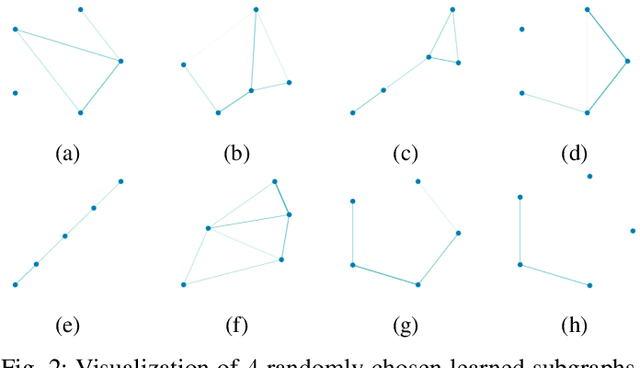
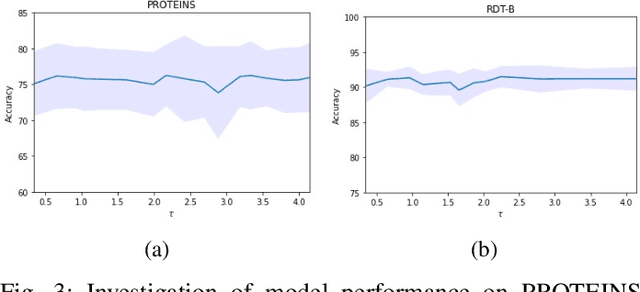
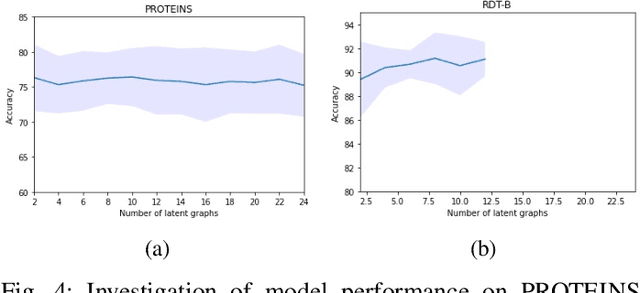
Abstract:Graph representation learning has now become the de facto standard when handling graph-structured data, with the framework of message-passing graph neural networks (MPNN) being the most prevailing algorithmic tool. Despite its popularity, the family of MPNNs suffers from several drawbacks such as transparency and expressivity. Recently, the idea of designing neural models on graphs using the theory of graph kernels has emerged as a more transparent as well as sometimes more expressive alternative to MPNNs known as kernel graph neural networks (KGNNs). Developments on KGNNs are currently a nascent field of research, leaving several challenges from algorithmic design and adaptation to other learning paradigms such as self-supervised learning. In this paper, we improve the design and learning of KGNNs. Firstly, we extend the algorithmic formulation of KGNNs by allowing a more flexible graph-level similarity definition that encompasses former proposals like random walk graph kernel, as well as providing a smoother optimization objective that alleviates the need of introducing combinatorial learning procedures. Secondly, we enhance KGNNs through the lens of self-supervision via developing a novel structure-preserving graph data augmentation method called latent graph augmentation (LGA). Finally, we perform extensive empirical evaluations to demonstrate the efficacy of our proposed mechanisms. Experimental results over benchmark datasets suggest that our proposed model achieves competitive performance that is comparable to or sometimes outperforming state-of-the-art graph representation learning frameworks with or without self-supervision on graph classification tasks. Comparisons against other previously established graph data augmentation methods verify that the proposed LGA augmentation scheme captures better semantics of graph-level invariance.
 Add to Chrome
Add to Chrome Add to Firefox
Add to Firefox Add to Edge
Add to Edge